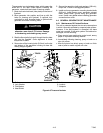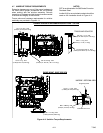
4-- 8T--343
c. Diode Testing
The rectifier diode assemblies can be tested, and if
damaged, replaced. Over current, over voltage, over
speed, or r everse currents can dam agethe assembly or
diodes. To remove the diode assemblies and perform
diode testing, do the following:
1. Remove thebearing c overby removingthe fourbolts
(see Figure 4-6). Both the bearing and diode
assemblies will be visible.
a.
g.
f.
e.
d.
c.
b.
a. Rectifier Flange
b. Rectifier Assembly
c. Rectifier Bolt
d. Bearin
g
Cover
e. Bearing Cover Bolt
f. Bearing
g. Bearing Cover Flange
Figure 4-6 Rectifier Removal
2. Mark and disconnect the alternator rotor wires at the
rectifier screw terminals. Note that the terminals a re
markedwith redpaint for theforward diodeassembly
and black for the reverse diode assembly. Mark and
disconnect the exciter leads from the double spade
terminals (see Figure 4-7).
a.
d.
c.
b.
a.
b.
d.
a. Diode Assembly
b. Diode Bridge
c. Exciter Rotor Lead Connection
d. Alternator Rotor Lead Connection
Figure 4-7 A-C Generator Rectifier Assembly
3. Remove the two c ap screws that secure each diode
assembly to the exiter. Once this procedure is
complete, thediode as semblies arefree for removal.
4. A forward diode should have a low resistance when
the + of an ohm meter is connected to the exciter
rotor lead connection (anode) and the - to the d iode
bridge (cathode), and a h igh resistance when the
polarity of the ohmmeter is reversed.
5. A reverse diode should have a high resistance when
the + of an ohm meter is connected to the exciter
rotor lead connection (anode) and the - to the d iode
bridge (cathode), and a low resistance when the
polarity of the ohmmeter is reversed.
6. If both resistances are high orboth arelow, the diode
is defective and the diode assembly should be
replaced.
4.5.3 Bearing Replacement
When operated under normal conditions,
factory--lubricated shielded bearings will normally
provide years of trouble--free service. Excessive
bearing load and adverse environment conditions will
greatly shorten bearing life. To remove the bearings, do
the following:
1. Remove bearing cover (See Figure 4-6).
2. Remove bearing with a bearing or wheel puller.
3. Install new bearing. Ball bearings are pre-lubricated
and require no additional lubrication for the life of the
bearing.
4. Coat mating surface of bearing cover flange with
anti-corrosion compound (Tef-Gel, Carrier Part
Number 02-00083-00). Replace bearing cover.
4.5.4 Generator Removal and Installation
a. Removing the Generator
1. Remove covers and ground wire from frame of
generator set.
2. Remove connection box cover and disconnect
power leads.
3. Remove screen cover and generator exhaust baf fle
from coupling end of generator .
4. Remove the six 8mm hex head bolts and washers
that secure the generator drive disc to the engine
flywheel. T urn bolts counter-clockwise with offset
wrench to start, then use flexible shaft and socket
assembly for removal of bolts.
5. Remove the twelve 3/8 inch hex head cap screws
and washers that secure generator frame to engine
flywheel housing.
6. Remove the four 5/8 inch bolts that secure the
generator mounting feet to the shockmount bracket,
then remove generator.
b. Installing the Generator
NOTE
For torque values refer to paragraph 4.7.


















